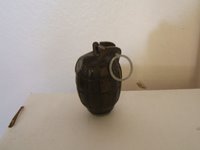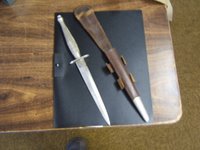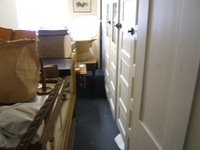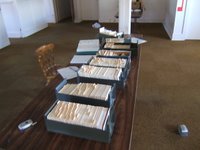The foundations of any museum collection are its records. Without good records, items can be lost, stories forgotten, and it can create endless headaches for the people left to deal with the situation. As I have shown, the Gananoque Museum, like so many other small museums, is packed full of military artefacts, such as this Mark 1
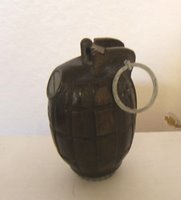 grenade that I mentioned a couple weeks back. I was leery of the grenade from the beginning, as others I have seen had the been drilled out so all could see that they were no longer full of explosives. This grenade had the bottom screwed on tightly, and I was not about to pop it open and see if there was anything left. I checked the records, and sure enough, the description read: “1 Mk 1 Grenade, WWII” and then gave its dimensions. There was nothing in the catalogue, or the files, to say that the item had ever been deactivated. Even though I suspected it was probably ok, I knew that it would be a costly mistake if I were wrong. So, I called the ammo specialist at CFBK, and he told me to alert the GFPD, who needed to call LFAC for an EUD. What does all that mean? We no longer have a grenade, which is likely for the best.
grenade that I mentioned a couple weeks back. I was leery of the grenade from the beginning, as others I have seen had the been drilled out so all could see that they were no longer full of explosives. This grenade had the bottom screwed on tightly, and I was not about to pop it open and see if there was anything left. I checked the records, and sure enough, the description read: “1 Mk 1 Grenade, WWII” and then gave its dimensions. There was nothing in the catalogue, or the files, to say that the item had ever been deactivated. Even though I suspected it was probably ok, I knew that it would be a costly mistake if I were wrong. So, I called the ammo specialist at CFBK, and he told me to alert the GFPD, who needed to call LFAC for an EUD. What does all that mean? We no longer have a grenade, which is likely for the best.On Tuesday I had the great pleasure of being given a tour of the Brockville Museum. I have never seen a small town museum, with only a couple of paid staff, run so well. The collection storage was immaculate, the records were all in order, the volunteers trained and operating as well as full-time, paid professionals. It was truly heartening to see what can be done with trained, dedicated staff and volunteers. The Brockville Museum should serve as a model for all community museums. www.brockvillemuseum.com
Bonnie Burke, the Curator/Director gave me a lot of wonderful advice. Many thanks to her, Brenda Foss, the Collections Manager, and Ruth MacFarlane, the Education Programmer, for all their time and interest in what we’re doing here in town. I am encouraged already by the many people in Gananoque who have come forward to volunteer their time to help preserve our town’s history. I am sure that in time Gananoque, too, can have a museum collection to be proud of.
The staff in Brockville also passed me a very interesting note from an Archival Curator in El Paso, Texas. It seems the land grant of one of our earliest Loyalist settlers, Oliver Landon, of Landon Bay fame, has ended up in Texas. Oliver Landon was one of many Loyalists who came to Leeds County from Litchfield, Connecticut, and how it ended up in Texas is a mystery. Luckily, the 200 year-old document will now find its way back home. More on this as information comes in.
 One final note, that has to do with the problems of poor record keeping, is this item here: The Victrola Talking Machine. I remember this phonograph when I worked in the museum as a teenager. Time has taken its toll since then: the
One final note, that has to do with the problems of poor record keeping, is this item here: The Victrola Talking Machine. I remember this phonograph when I worked in the museum as a teenager. Time has taken its toll since then: the  mechanism no longer seems to work, and the finish has seen better days. I was alerted to the item by a Gananoque resident who was eager to finally have it back – being that it was loaned to the museum decades ago. Never properly recorded, memory of it being loaned was lost, and the Victrola and all its individual record albums and parts were improperly accessioned into the permanent collections in 1999. This has now caused some interesting cataloguing issues. Luckily, the loaner retained her paperwork, and it can now be returned to its rightful owner.
mechanism no longer seems to work, and the finish has seen better days. I was alerted to the item by a Gananoque resident who was eager to finally have it back – being that it was loaned to the museum decades ago. Never properly recorded, memory of it being loaned was lost, and the Victrola and all its individual record albums and parts were improperly accessioned into the permanent collections in 1999. This has now caused some interesting cataloguing issues. Luckily, the loaner retained her paperwork, and it can now be returned to its rightful owner. In a fantastic coincidence, flipping through a pile of pre-WWI magazines, I came across this add from January, 1913. At $200.00 this phonograph would have been a treasured family possession, and I am very glad I was able to return it. This little instance shows the need to get these records in order, and the serious, yet unrealized potential for the collections.
In a fantastic coincidence, flipping through a pile of pre-WWI magazines, I came across this add from January, 1913. At $200.00 this phonograph would have been a treasured family possession, and I am very glad I was able to return it. This little instance shows the need to get these records in order, and the serious, yet unrealized potential for the collections.For anyone who has offered to volunteer or would like to volunteer, there will be a meeting at the Arthur Child Museum at 7pm Monday October 30th. If you would like information and cannot attend please e-mail me at tcompeau@gmail.com.



 These are two World War II gasmasks. The adult version is quite common, but the child’s mask is much rarer. Called a “Mickey Mouse” gas mask in the old catalogue, it was meant for children 5 and under. The accompanying box has a strap which would have been worn around the child’s neck, making the mask readily at hand in case of a Nazi gas attack.
These are two World War II gasmasks. The adult version is quite common, but the child’s mask is much rarer. Called a “Mickey Mouse” gas mask in the old catalogue, it was meant for children 5 and under. The accompanying box has a strap which would have been worn around the child’s neck, making the mask readily at hand in case of a Nazi gas attack.
